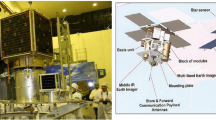Abstract
The QUEST measurement noise model for unit vector observations has been widely used in spacecraft attitude estimation for more than twenty years. It was derived under the approximation that the noise lies in the tangent plane of the respective unit vector and is axially symmetrically distributed about the vector. For large field-of-view sensors, however, this approximation may be poor, especially when the measurement falls near the edge of the field of view. In this paper a new measurement noise model is derived based on a realistic noise distribution in the focal plane of a large field-of-view sensor, which shows significant differences from the QUEST model for unit vector observations far away from the sensor boresight. An extended Kalman filter for attitude estimation is then designed with the new measurement noise model. Simulation results show that with the new measurement model the extended Kalman filter achieves better estimation performance using large field-of-view sensor observations.
Similar content being viewed by others
References
WERTZ, J. R. Mission Geometry; Orbit and Constellation Design and Management, Chapter 3, Microcosm Press, El Segundo, CA and Kluwer Academic Publishers, Dordrecht, Netherlands, 2001, pp. 152–167.
PSIAKI, M. L., MARTEL, F., and PAL, P. K. “Three-Axis Attitude Determination via Kalman Filtering of Magnetometer Data,” Journal of Guidance, Control, and Dynamics, Vol. 13, No. 3, May–June 1990, pp. 506–514.
CHALLA, M., NATANSON, G., and WHEELER, C. “Simultaneous Determination of Spacecraft Attitude and Rates Using Only a Magnetometer,” presented as paper AIAA-1996-3630 at the AIAA/AAS Astrodynamics Specialists Conference, San Diego, CA, July 29–31, 1996.
JU, G. and JUNKINS, J. L. “Overview of Star Tracker Technology and its Trends in Research and Development,” Advances in the Astronautical Sciences, The John L. Junkins Astrodynamics Symposium, Vol. 115, 2003, pp. 461–478.
SHUSTER, M. D. “Maximum Likelihood Estimation of Spacecraft Attitude,” The Journal of the Astronautical Sciences, Vol. 37, No. 1, Jan.–March 1989, pp. 79–88.
LIGHT, D. L. “Satellite Photogrammetry,” Manual of Photogrammetry, edited by C. C. Slama, Chapter 17, American Society of Photogrammetry, Falls Church, VA, 4th ed., 1980.
GRIFFITH, D. T., SINGLA, P., and JUNKINS, J. L. “Autonomous On-Orbit Calibration Approaches for Star Tracker Cameras,” presented as paper AAS-02-102 at the AAS/AIAA Space Flight Mechanics Meeting, San Antonio, TX, Jan. 27–30, 2002.
SHUSTER, M. D. “Kalman Filtering of Spacecraft Attitude and the QUEST Model,” The Journal of the Astronautical Sciences, Vol. 38, No. 3, July–Sept. 1990, pp. 377–393.
SHUSTER, M. D. and OH, S. D. “Three-Axis Attitude Determination from Vector Observations,” Journal of Guidance and Control, Vol. 4, No. 1, Jan.–Feb. 1981, pp. 70–77.
CHENG, Y. and CRASSIDIS, J. L. “Particle Filtering for Sequential Spacecraft Attitude Estimation,” presented as paper AIAA-04-5337 at the AIAA Guidance, Navigation, and Control Conference, Providence, RI, Aug. 16–19, 2004.
JUNKINS, J. L., HUGHES, D. C., WAZNI, K. P., and PARIYAPONG, V. “Vision Based Navigation for Rendezvous, Docking and Proximity Operations,” presented as paper AAS-99-021 at the 22nd Annual AAS Guidance and Control Conference, Breckenridge, CO, Feb. 7–10, 1999.
SHUSTER, M. D. “Erratum: Kalman Filtering of Spacecraft Attitude and the QUEST Model,” The Journal of the Astronautical Sciences, Vol. 51, No. 3, July–Sept. 2003, pp. 359.
LEFFERTS, E. J., MARKLEY, F. L., and SHUSTER, M. D. “Kalman Filtering for Spacecraft Attitude Estimation,” Journal of Guidance, Control, and Dynamics, Vol. 5, No. 5, Sept.–Oct. 1982, pp. 417–429.
CRASSIDIS, J. L. and JUNKINS, J. L. Optimal Estimation of Dynamic Systems, Chapter 5, Chapman & Hall/CRC, Boca Raton, FL, 2004.
MURRELL, J.W. “Precision Attitude Determination for Multimission Spacecraft,” Proceedings of the AIAA Guidance, Navigation, and Control Conference, Palo Alto, CA, Aug. 7–9, 1978, pp. 70–87.
WILKINSON, J.H. The Algebraic Eigenvalue Problem, Clarendon Press, Oxford, England, 1965, pp. 94–97.
FARRENKOPF, R. L. “Analytic Steady-State Accuracy Solutions for Two Common Spacecraft Attitude Estimators,” Journal of Guidance and Control, Vol. 1, No. 4, July–Aug. 1978, pp. 282–284.
CRASSIDIS, J. L. and MARKLEY, F. L. “Unscented Filtering for Spacecraft Attitude Estimation,” Journal of Guidance, Control, and Dynamics,Vol. 26, No. 4, July–Aug. 2003, pp. 536–542.
Author information
Authors and Affiliations
Corresponding author
Rights and permissions
About this article
Cite this article
Cheng, Y., Crassidis, J.L. & Markley, F.L. Attitude estimation for large field-of-view sensors. J of Astronaut Sci 54, 433–448 (2006). https://doi.org/10.1007/BF03256499
Published:
Issue Date:
DOI: https://doi.org/10.1007/BF03256499




